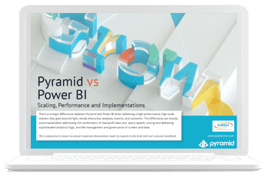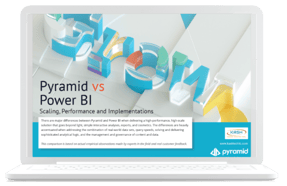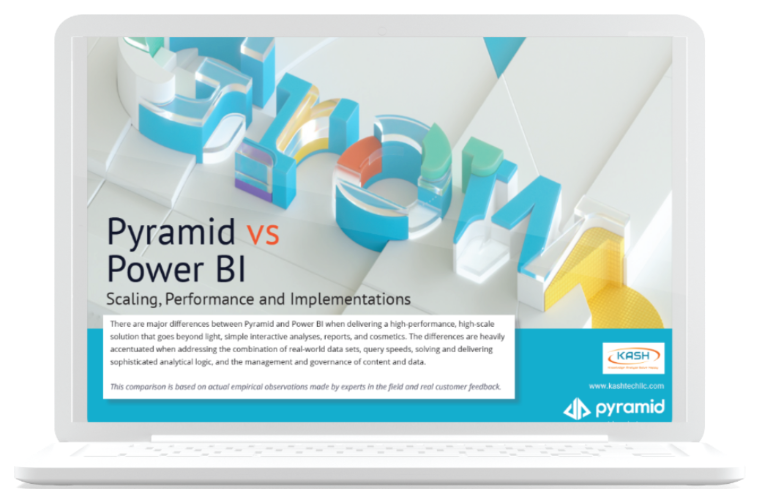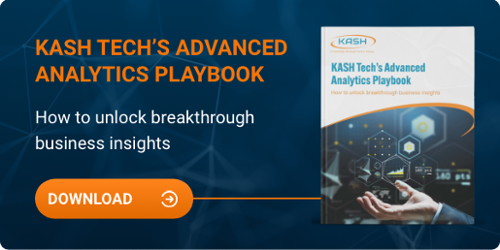Contents
What are the Differences Between Pyramid and Power BI?
There are major differences between Pyramid and Power BI when delivering a high-performance, high-scale
solution that goes beyond light, simple interactive analyses, reports, and cosmetics. The differences are heavily accentuated when addressing the combination of real-world data sets, query speeds, solving and delivering sophisticated analytical logic, and the management and governance of content and data.
This comparison is based on actual empirical observations made by experts in the field and real customer feedback.
Download Your Personal
Copy of the eBook

Fill out the form to receive your copy of the eBook.
Download the eBook
Scalability & Performance
User adoption of slow-performing analytic solutions is incredibly low. There is little point in implementing a solution that no one uses.
Power BI’s performance plummets with increasing data sizes, semantic model complexity, the number of
users and/or complex business logic.
Pyramid, on the other hand, has the fastest query engine in the market. By working directly on the data source, it is not affected by data volumes, model complexity, data breadth, or user concurrency.
Semantic/Data Models
World-class semantic modeling allows solutions to match real-world data designs and accelerate delivery without any performance impact. Weak semantic tools force BI developers to heavily manipulate data structures and logic - extending delivery times & complicating maintenance.
![]() Due to the architecture of Power BI’s data engine, a real-world semantic model structure with many joins, foreign keys, tables, attributes, and numerous metrics exponentially impacts the performance and scalability of Power BI negatively.
Due to the architecture of Power BI’s data engine, a real-world semantic model structure with many joins, foreign keys, tables, attributes, and numerous metrics exponentially impacts the performance and scalability of Power BI negatively.
![]() Pyramid’s PYRANA query engine facilitates
Pyramid’s PYRANA query engine facilitates
a flexible, high-performance approach to semantic model design. Regardless of how many
joins, keys, tables, attributes or measures, queries remain super performant. And without performance constraints, data modeling can easily match real-world data scenarios.
Analytic Formulations & Code
Analytic formulations are the bedrock of solving complicated business questions. Performance considerations should never be a disincentive to using them.
![]() Power BI’s DAX coding language used in
Power BI’s DAX coding language used in
advanced formulas and last mile data manipulations heavily impacts performance.
It also lacks numerous hierarchical operations
to solve classic analytical problems, forcing mind-bending work arounds and numerous data hacks.
![]() The Pyramid Query Language (PQL) is robust, powerful and comprehensive – resolving
The Pyramid Query Language (PQL) is robust, powerful and comprehensive – resolving
sophisticated analytic formulations through ANSI
SQL constructs. PQL operates without any significant performance impact - regardless of formula or model complexity or their size and depth.
Data Security
Security considerations appear in over 95% of all serious implementations. Deploying a secure data analytics solution should not come with any performance penalty.
![]() Row level security in Power BI is implemented through the DAX formula engine – adding
Row level security in Power BI is implemented through the DAX formula engine – adding
another significant and compounding factor that
impacts both performance and complexity.
![]() Row level security in Pyramid can be implemented simply through the data model
Row level security in Pyramid can be implemented simply through the data model
structure itself and resolves using standard SQL
operations, with a negligible impact on performance.
Direct Query
Data is growing exponentially and cannot fit into 'memory-only' technologies. Analytic technologies that cannot fully operate directly on external data stacks heavily retard real-world data analysis and solutions.
![]() Power BI’s direct query interface only delivers
Power BI’s direct query interface only delivers
basic querying. Any advanced logic is complicated to enact or unavailable. This pushes
solutions towards using the Power BI in-memory Tabular solution instead, which has its own bottlenecks and performance issues.
![]() The PYRANA query engine is a direct query
The PYRANA query engine is a direct query
engine. Every aspect of its query and advanced logic handling works on any SQL-based
technology. This gives customers the freedom to
choose one or more data stack alternatives based on
business purpose, scaling requirements or cost.
In-Memory
In-memory solutions are a super-fast, convenient option for handling smaller data sets. However, not all memory-based engines are created equal with significant differences in data handling and query performance.
![]() The Power BI Tabular database does not handle large data volumes or high concurrency well. Further, request memory is capped (up to ~10Gb) – which becomes a major limiting
The Power BI Tabular database does not handle large data volumes or high concurrency well. Further, request memory is capped (up to ~10Gb) – which becomes a major limiting
factor when data grows.
![]() Pyramid’s optional in-memory database uses standard SQL constructs so it handles large, broad data sets and queries efficiently without request size limits. The efficiency also delivers far better concurrency rates.
Pyramid’s optional in-memory database uses standard SQL constructs so it handles large, broad data sets and queries efficiently without request size limits. The efficiency also delivers far better concurrency rates.
Parallel Processing
Data stories involve presenting multiple components with multiple queries, in a single view. The inability to deliver this experience, across a concurrent user group, severely challenges the practicalities of organizational data-driven decision-making for everyone.
![]() Resolving too many analytic components simultaneously severely impacts the overall speed and user experience in a Power BI dashboard. The same impact is observed as user concurrency grows. Both compel designers to limit the scope of content in any given instance.
Resolving too many analytic components simultaneously severely impacts the overall speed and user experience in a Power BI dashboard. The same impact is observed as user concurrency grows. Both compel designers to limit the scope of content in any given instance.
![]() Pyramid’s scale-out architecture allows customers to run as many concurrent queries in parallel as required – whether they are generated from multiple components executing simultaneously or from growing user engagement, or both.
Pyramid’s scale-out architecture allows customers to run as many concurrent queries in parallel as required – whether they are generated from multiple components executing simultaneously or from growing user engagement, or both.
Deployment & Implementations
Creating a “single source of the truth” is one of the top objectives for customers. Allowing users to create duplicates and to work outside a centralized framework defeats this goal and exposes governance risk and systemic inefficiencies.
Power BI’s siloed projects approach for content, logic and data compels duplication and redundancy. Destroying any attempt to centralize analytics and data, Power BI makes the management and maintenance of multiple projects highly problematic and very costly.
Pyramid’s centralized design, on the other hand, allows all content, business logic and semantic elements to be housed in a singular location. This greatly simplifies governance and security while encouraging common elements to be reused across multiple projects - reducing management, maintenance, complexity and ultimately, cost.
Content Sharing
Using common logic elements and constructs is a key step to eliminating confusion and inconsistency and ultimately building trust. The loss of trust in the data or analysis is one of the first casualties in many analytics solutions that operate through siloes.
![]() Power BI’s siloed project architecture makes the usage and re-usage of common business logic elements impossible. This engenders both duplication of efforts as well as inconsistencies
Power BI’s siloed project architecture makes the usage and re-usage of common business logic elements impossible. This engenders both duplication of efforts as well as inconsistencies
in reporting, logic and treatments across an enterprise implementation.
![]() Content and business logic in Pyramid can
Content and business logic in Pyramid can
be naturally cross-used and reused multiple times across different projects and analyses because it's centralized. Duplication and inconsistencies are practically eliminated, and collective knowledge, collaboration and trust are dramatically increased.
Governance
Governance ensures that the right data, analyses, and logic is created, used and accessed by the right people at the right time. A lack of governance and control foments a retarding force to scale and accelerate quality solutions across the enterprise.
![]() The combination of siloed content and an untethered desktop authoring tool complicates and weakens governance and security in Power BI - allowing users to operate detached; creating their own unsanctioned data models, business logic and visualizations.
The combination of siloed content and an untethered desktop authoring tool complicates and weakens governance and security in Power BI - allowing users to operate detached; creating their own unsanctioned data models, business logic and visualizations.
![]() All content, data and logic is housed and
All content, data and logic is housed and
centralized in Pyramid’s server-based platform for both authors and consumers. Governance is natively built into the solution, making
control and security a natural externality of implementation by design.
Coding & Maintainability
Advanced logic and calculations are often required for many real business problems. Making these capabilities difficult or complicated effectively blocks end-users from building and resolving the required logic and dramatically hinders self-service decision-making.
![]() Power BI’s DAX query language is complex
Power BI’s DAX query language is complex
with a very steep learning curve - making the job of writing and maintaining logic problematic and very costly. With few point-and-click, no-code options, Power BI requires the participation of advanced developers for most real-world implementations.
![]() Powerful calculations in Pyramid can be built
Powerful calculations in Pyramid can be built
without writing a line of code. Its graphical formula builder further allows end users to self-write, manipulate, and maintain customized logic with point-and-click simplicity. In Pyramid, sophistication does not come at the cost of complexity.
Download Your Personal
Copy of the eBook

Fill out the form to receive your copy of the eBook.
Download the eBook
KASH Tech’s Four-Phase Process to Produce Custom Solutions
At KASH Tech, we follow a four-phase process to address clients’ needs and provide a custom solution to digital transformation challenges. Each client gets a Best-of-Fit solution for their unique configuration. This methodology includes a detailed analysis to provide a comprehensive strategy for implementation.
Discover how your organization can unlock advanced business intelligence, eliminate data silos, and create actionable business insights. Download the free eBook, KASH Tech’s Advanced Analytics Playbook: How to Unlock Breakthrough Business Insights.
If you’re ready to explore solutions, request a data and analytics discovery call from the KASH Tech team.

